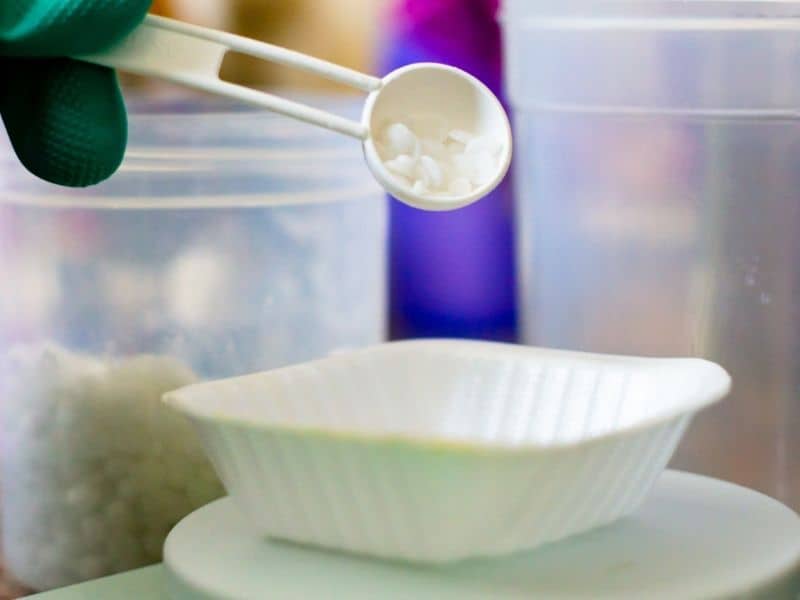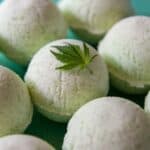Lye is an important ingredient when it comes to soap making, as are all of the ingredients. Lye is responsible for the chemical reaction called saponification. This is what turns the oils into soap. Without lye, there would be no soap! So, how do you measure lye for soap making?
Measure lye for soap making by measuring weight. You will need a kitchen scale or a jeweler’s scale to measure the lye. You need approximately 1:2 lye to water for making soap which would be 33% lye and 66% water. This amount can vary depending on your recipe.
Some recipes and oil types will require more or less lye than others so it is important to always check with the recipe that you are using. However, no matter which recipe you use, you will always measure your ingredients by weight.
Measuring Ingredients by Weight
As mentioned above it is important to always measure your ingredients by weight and not by volume. This is especially true when it comes to lye.
Lye can be compacted and compressed and the volume can change while the weight remains the same.
The only way to get a 100% accurate measurement for the amount of lye you are using is to measure it by weight. For this, I suggest using kitchen scales or jewelers scales.
Is Lye Necessary?
Lye is a necessary ingredient in soap making.
While there are lye-free soap recipes available, lye is what makes soap…soap.
Lye-free soap recipes use other ingredients like ashes or milk to saponify the oils but these methods are not as effective or reliable as using lye.
If you choose to make lye-free soap, know that your soap will not be true soap, but more of a detergent bar. It will clean your skin but it will not have the same properties as soap that is made with lye.
How Lye Works in Soap Making
As mentioned above, lye is what makes soap “soap”.
Soap is the result of a chemical reaction called saponification.
Saponification is the reaction that occurs when lye is combined with oils to create soap.
During saponification, the lye reacts with the fatty acids in the oils to form soap.
The lye is then neutralized and the soap is safe to use.
Pros and Cons of Using Lye in Soap Making
There are both pros and cons to using lye in soap making.
PROS:
- Lye is necessary to make soap
- Lye creates a more reliable and effective soap recipe
CONS:
- Lye is a dangerous chemical if not handled properly
- Lye can be corrosive and damaging to skin and eyes
- Lye can be poisonous if ingested
As you can see, there are both pros and cons to using lye in soap making.
It is important to weigh the pros and cons before deciding if using lye is right for you.
If you do decide to use lye, be sure to handle it with caution and follow all safety precautions.
Alternatives to Lye in Soap Making
If you decide not to use lye in soap making, there are a few alternatives that you can use.
Ashes: You can make lye-free soap using ashes. This was one of the first methods used to make soap.
To make lye from ashes, you will need to mix the ashes with water and strain it through a cloth. The lye-water that is left can then be used in your soap recipe.
Milk: Milk can also be used to saponify oils in lye-free soap recipes.
To do this, you will need to add milk to your oils and mix until combined. Then, you will need to add a catalyst like salt or baking soda to help the saponification process along.
While lye-free soap recipes are available, lye is necessary to make soap.
How to Make Soap Without Lye
Using Ashes to Make Soap
If you decide not to use lye in soap making, one of the alternatives that you can use is ashes.
To make lye from ashes, you will need to mix the ashes with water and strain it through a cloth. The lye-water that is left can then be used in your soap recipe.
To make lye from ashes, you will need:
– 1 cup of ashes
– 2 cups of water
– A strainer
– A lye-safe container
First, you will need to mix the ashes and water together. Once mixed, allow the mixture to sit for at least 24 hours.
After 24 hours, strain the mixture through a cloth into a lye-safe container.
The lye-water that is left can be used in your soap recipe.
Just be sure to add the lye-water slowly and carefully so that you do not accidently splash it or get it on your skin.
Using Milk to Make Soap
Another alternative that you can use to make lye-free soap is milk.
To make lye-free soap using milk, you will need to add milk to your oils and mix until combined. Then, you will need to add a catalyst like salt or baking soda to help the saponification process along.
To make lye-free soap using milk, you will need:
– 1 cup of milk
– 1 cup of oils
– 1 teaspoon of salt or baking soda
First, you will need to add the milk and oils to a lye-safe container.
Then, you will need to add a teaspoon of salt or baking soda to the mixture.
Mix the ingredients together until they are fully combined.
Allow the mixture to saponify for 24 hours.
After 24 hours, your lye-free soap will be ready to use.
Frequently Asked Questions
Lye is a caustic substance that is used in soap making.
Saponification is the reaction that occurs when lye is combined with oils to create soap.
While lye-free soap recipes are available, lye is necessary to make soap.
You can make lye-free soap using ashes.
To make lye-free soap using ashes, you will need to mix the ashes with water and strain it through a cloth. The lye-water that is left can then be used in your soap recipe.
Ashes and milk are two alternatives that can be used to make lye-free soap.
When handling lye, be sure to wear gloves and eye protection. Lye can be corrosive and damaging to skin and eyes.
Conclusion
In conclusion, the best way to measure lye for soap making is to measure it by weight. You can measure it with a kitchen scale or a digital scale, however, you must find a way to accurately measure it and your other soap-making ingredients.
Once you have mastered the recipe you start learning with then you can begin making changes to the recipe and customize it to meet your own needs.






